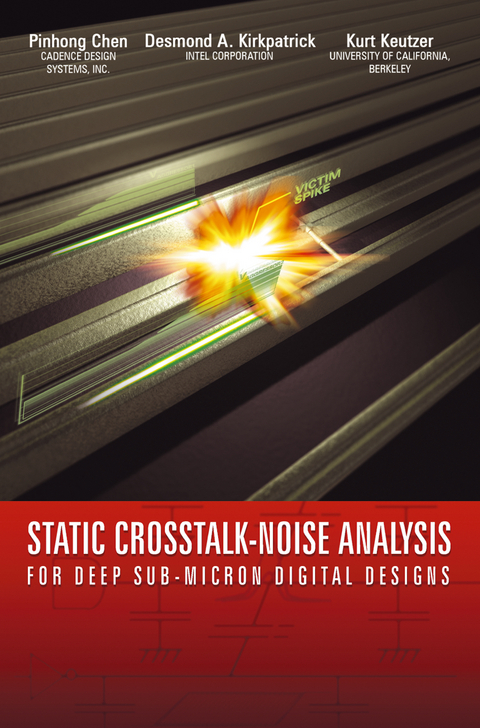Static Crosstalk-Noise Analysis
For Deep Sub-Micron Digital Designs
Seiten
2004
|
2004 ed.
Springer-Verlag New York Inc.
978-1-4020-8091-3 (ISBN)
Springer-Verlag New York Inc.
978-1-4020-8091-3 (ISBN)
As the feature size decreases in deep sub-micron designs, coupling capacitance becomes the dominant factor in total capacitance. This book describes methods for computing delay variation due to coupling. Most of these methods are computationally efficient enough to be employed in a static timing analysis tool for integrated digital circuits.
As the feature size decreases in deep sub-micron designs, coupling capacitance becomes the dominant factor in total capacitance. The resulting crosstalk noise may be responsible for signal integrity issues and significant timing variation. Traditionally, static timing analysis tools have ignored cross coupling effects between wires altogether. Newer tools simply approximate the coupling capacitance by a 2X Miller factor in order to compute the worst case delay. The latter approach not only reduces delay calculation accuracy, but can also be shown to underestimate the delay in certain scenarios.
This book describes accurate but conservative methods for computing delay variation due to coupling. Furthermore, most of these methods are computationally efficient enough to be employed in a static timing analysis tool for complex integrated digital circuits. To achieve accuracy, a more accurate computation of the Miller factor is derived. To achieve both computational efficiency and accuracy, a variety of mechanisms for pruning the search space are detailed, including:
-Spatial pruning - reducing aggressors to those in physical proximity,
-Electrical pruning - reducing aggressors by electrical strength,
-Temporal pruning - reducing aggressors using timing windows,
-Functional pruning - reducing aggressors by Boolean functional analysis.
As the feature size decreases in deep sub-micron designs, coupling capacitance becomes the dominant factor in total capacitance. The resulting crosstalk noise may be responsible for signal integrity issues and significant timing variation. Traditionally, static timing analysis tools have ignored cross coupling effects between wires altogether. Newer tools simply approximate the coupling capacitance by a 2X Miller factor in order to compute the worst case delay. The latter approach not only reduces delay calculation accuracy, but can also be shown to underestimate the delay in certain scenarios.
This book describes accurate but conservative methods for computing delay variation due to coupling. Furthermore, most of these methods are computationally efficient enough to be employed in a static timing analysis tool for complex integrated digital circuits. To achieve accuracy, a more accurate computation of the Miller factor is derived. To achieve both computational efficiency and accuracy, a variety of mechanisms for pruning the search space are detailed, including:
-Spatial pruning - reducing aggressors to those in physical proximity,
-Electrical pruning - reducing aggressors by electrical strength,
-Temporal pruning - reducing aggressors using timing windows,
-Functional pruning - reducing aggressors by Boolean functional analysis.
Miller Factor Computation for Coupling Delay.- Convergence of Switching Window Computation.- Speeding-Up Switching Window Computation.- Refinement of Switching Windows.- Functional Crosstalk Analysis.- Conclusions.
| Zusatzinfo | XVIII, 113 p. |
|---|---|
| Verlagsort | New York, NY |
| Sprache | englisch |
| Maße | 155 x 235 mm |
| Themenwelt | Informatik ► Weitere Themen ► CAD-Programme |
| Technik ► Elektrotechnik / Energietechnik | |
| Technik ► Nachrichtentechnik | |
| Schlagworte | Chen |
| ISBN-10 | 1-4020-8091-3 / 1402080913 |
| ISBN-13 | 978-1-4020-8091-3 / 9781402080913 |
| Zustand | Neuware |
| Haben Sie eine Frage zum Produkt? |
Mehr entdecken
aus dem Bereich
aus dem Bereich
Buch | Softcover (2023)
Beuth (Verlag)
99,00 €
Einführung in die Geometrische Produktspezifikation
Buch | Softcover (2023)
Europa-Lehrmittel (Verlag)
20,70 €




